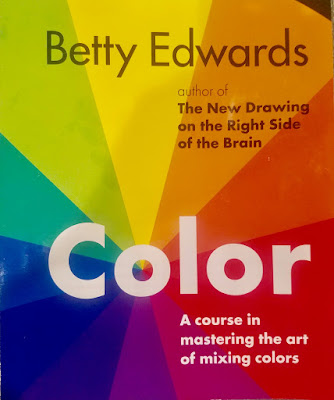COLOR THEORY AND HARMONY
I recently posted on the two types of color wheel. It is very important to learn how to use a color wheel in order to be proficient in mixing our colors as we paint. Many top artists work with a limited palette. The purpose is that when we use just a few colors and mix our paints, everything coordinates and there is harmony in our paintings, and it also saves money! Some artists work with as few as four colors, others use eight, and then, there are those who use a lot of colors, choosing to purchase the colors already mixed to save time and perhaps out of fear of getting the wrong color if they try mixing.
I have been studying Betty Edwards book, "COLOR, A Course in Mastering the Art of Mixing Colors". In it she states the importance of memorizing the color wheel. Then keeping it close by as we paint for quick referral. She has a doctorate in art and teaches in a California college, so if we get and study her book, we are taking a college level course! It is great and not too difficult to follow so I will be including some of it in my Acrylic Art class curriculum. The templates and exercises in the book are excellent for teaching color theory and the students will become familiar with the process of "seeing" and mixing colors to achieve the all-important harmony in their paintings. I am excited to begin working with them and see how they progress. If it goes as well, as I think it will, I may just make it a separate and expanded class.
If you haven't seen or read this book, I strongly recommend you purchase one. ($16 new on Amazon, less for used) Of course you may already be an expert at mixing and color harmony. I don't claim to be, but I've learned enough that I can help others understand how her methods work and how to use her charts to become better artists. It does require practice and patience, but the results are well worth it. In her book are templates to cut out to make the multiple charts that are used to learn her methods. As we make these charts, we are learning, and when we finish the charts, the principles are fixed in our minds and we've learned a LOT! Interestingly, she explains how the eye sees harmonious colors and she provides examples to prove that fact. They are fascinating to say the least!
Hopefully this has whet your appetite for learning more about mixing color and harmony in your paintings. Below is a picture of the book if you would like to get one. Thanks and Enjoy!
 |
| 'COLOR" by Betty Edwards |

